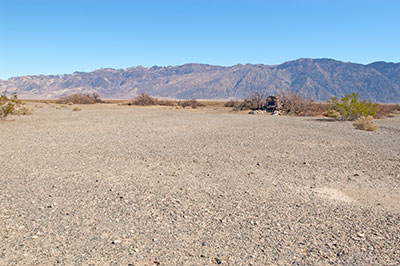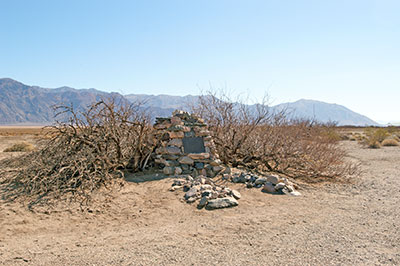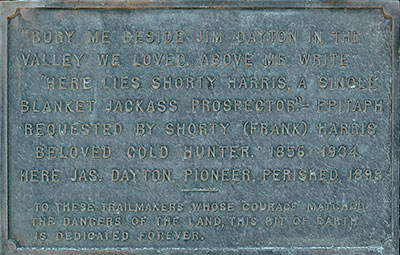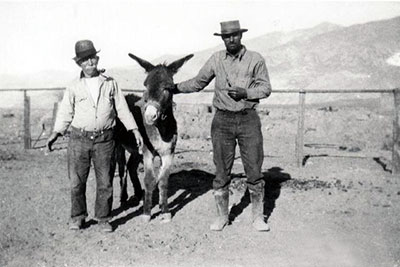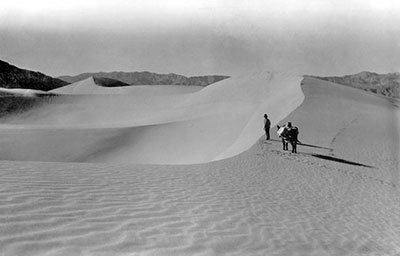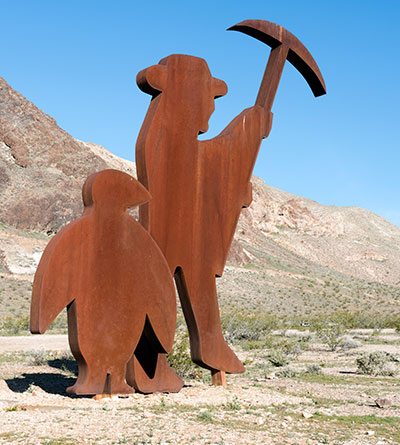Inyo County Points of Interest
West Side Road
Death Valley National Park
Bury me beside Jim Dayton in the valley we loved. Above me write: "Here lies Shorty Harris, a single blanket jackass prospector."
Epitaph requested by Shorty (Frank) Harris, beloved gold hunter, 1856-1934
Here Jas. Dayton, pioneer, perished, 1898. To these trailmakers whose courage matched the dangers of the land, this bit of earth is dedicated forever.
Frank "Shorty" Harris (1857-1934) was born in Rhode Island and headed west when he was twenty. Before arriving in Death Valley, Harris prospected in Leadville (Colorado), Tombstone (Arizona), Coeur d'Alene (Idaho). In Nevada and Death Valley he prospected in Ballarat, Tonopah, Goldfield, Bullfrog and Rhyolite.
Harris was five feet, four inches tall. People said that he could smell gold. After making a claim, Harris didn't work the claim. He preferred talking and drinking in saloons to mucking in goldfields.
Harris died in his cabin at Big Pine in 1934 at the age of seventy-seven.

On 16 November 1934, the Inyo Independent reported the funeral of Shorty Harris in Death Valley:
"While the sun sank slowly into the purple haze that filters over Death Valley at twilight and taps sounded in the clear air of this mysterious land he knew so well, "Shorty" Harris, miner, Good Samaritan and friend to all who knew him, was laid to rest in a dusty grave on the valley floor last Sunday afternoon.
"He was laid beside the grave of his old pal and friend, Jim Dayton, long a respected pioneer prospector of Death Valley region.
"Shorty Harris, dean of all desert prospectors, died at the age of 74 years in a cabin at Big Pine, where he had sought rest and health following an illness about a year ago. He passed away in the restful sleep that he had sought.
"In deference to his request, he was buried at the "bottom of Death Valley", beside his partner. He had prospected with Jim Dayton many years ago in search for the yellow metal.
"The simple service, when the last rights [sic] were pronounced, was beautiful in the quiet solitude of the great valley. Chaplain Henry of the C.C.C. camp at Cow Creek, officiated at the open-air burial service. One hundred and fifty C.C.C. boys were present, bowing their heads out of respect to the grand old man of the desert, whose stories of early Death Valley, of burro-prospecting days, have been chronicled far and wide by writers of national repute.
"The body was lowered in the grave exactly at sunset and more than 300 people stood quietly at attention as taps sounded.
"Arraignments [sic] for the funeral ware [sic] made by Wm. Carruthers of Ontario and Supervisor Chas. Brown of Shoshone. The body was taken to Death Valley by Dewy Albright.
"Many old timers of the valley were present at the services, including Mr. Zabriskie of Pacific Coast Borax Co. and Bob Montgomery, who originally located Rhyolite and the Shoshone mine, and had not been in the valley for some 30 years.
"The burial of "Shorty" Harris went down in history as the first Christian burial in Death Valley, altho [sic] there had been many more who were buried there in shallow graves before, without Christian service."

Shorty Harris spent time in Rhyolite, Nevada, across Daylight Pass from Death Valley.
Just outside of Rhyolite, stands a rusted metal sculpture of Shorty Harris, twenty-four feet tall. The site-specific sculpture was created in 1994 by Fred Bervoets for the Goldwell Open Air Art Museum.
Because crazy is normal in the desert, the sculpture of Shorty is accompanied by a penguin and the Goldwell Open Air Art Museum in the Mojave Desert was founded by Belgian artists. From Belgium.
Why the penguin?
According to the museum, the penguin is a self-portrait of the artist. The penguin symbolized Bervoets' feeling of displacement in the Nevada desert.
Another source, Rhyolite caretaker Clint Boehringer has a different version:
"Did you see the statue of the miner with the penguin behind him? That's a tribute to Shorty. When he'd be out on the desert and would take up drinking from his bottle of O, be Joyful, after a time he'd look behind him and see a penguin following him around. He didn't see pink elephants, he saw penguins." (Source: DesertUSA)
